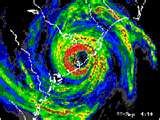• Crisscross your windows with masking tape. It's
a waste of time when you could spend doing something that might actually protect your home. All you'll get for your troubles
is windows covered with hard-to-remove gunk. Tape does not protect your windows. Don't believe us? Tape up a window, then
hit it with a baseball bat. Told you.
• Drill four holes in the center of the plywood
panels you put over your windows. All this does is give high winds a way to get at your windows.
• Protect only the windows and doors facing the
ocean. Bogus. You need protection on all sides. Winds can come from any direction or angle and may quickly change direction.
• Run around the house during the worst of the
storm opening the windows on what you perceive to be the "wind" side (or the non-wind side, depending on which myth you buy
into) at any given moment. This is bad advice for several reasons: (a) The wind is roaring from all directions; there
is no one "wind" side. (b) You want to keep the wind out of the house, period. There is no circumstance under which letting
150 mph winds inside your house is a good idea. (c) At the height of the storm you ought to be in a protected room, not running
around the house opening windows.
• I live inland, so I'm safe. Hurricanes threaten
only coastal areas. If you evacuated to Orlando in 2004 to escape Hurricane Charley, you know this isn't true. The residents
of Polk County were slammed three times that year by hurricanes. Inland flooding was a major problem around Tampa Bay because
of Frances and Jeanne in 2004. Inland areas are just as danger-prone as the coast.
• Do nothing. The county will come take you off
the barrier island if it gets really bad.Sorry, folks. Evacuate when you're told to. The weather may be beautiful, clear and
sunny in the hours leading up to landfall. Emergency-management directors say every year that they won't send "first responders"
into life-threatening situations to rescue you as the hurricane makes landfall. The more complicated your rescue (you're elderly
or disabled, or you require complicated medical equipment), the sooner you need to leave.
• Once a hurricane passes, the worst is over. Survivors
of Hurricane Katrina will beg to differ with you on this. Sometimes the worst is just beginning once the storm passes. The
strongest winds may have died down, but there can be tornadoes, rain and flooding after a hurricane. It may be days, weeks,
months before the power comes back on, your home is repaired and life returns to normal.

